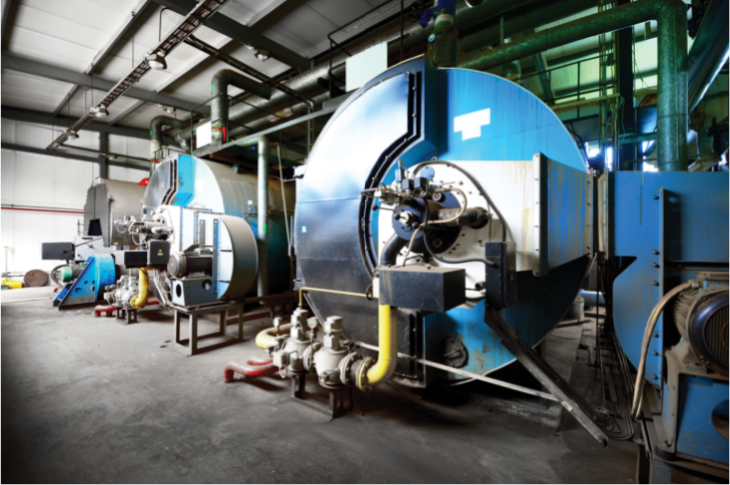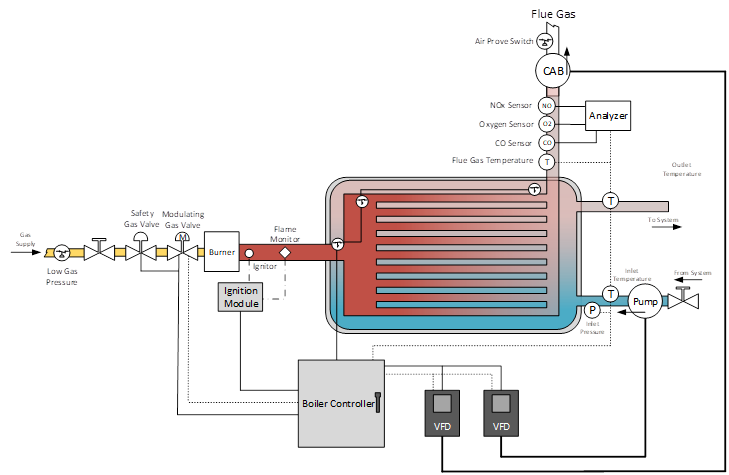Capstone uses sustainable approach to make old boilers new again

Reduce, reuse, recycle and retrofit — a team of SAIT students used their final project to develop a control system that brings classic industrial boilers up to modern emissions standards.
David Kaytor and Jason Single, now SAIT grads, designed the boiler control system for their Electrical Engineering Technology (EET) capstone project.
“Our capstone aimed to take an older boiler and update it with modern technology to improve its performance, efficiency and emissions,” says David Kaytor. “The end result was proof that an older system could be upgraded and made more efficient with some relatively minor additions and intelligent design.”
The project was named one of seven finalists for the Association of Science and Engineering Technology Professionals of Alberta’s (ASET) Capstone Project of the Year Award. The award recognizes engineering technology students who demonstrate innovation and ingenuity.
Green steam ahead
Industrial boilers are used to produce steam or heat process water for various industrial applications.
The emissions of classic industrial boilers fall far short of meeting today’s standards. Through a series of upgrades, the team was able to maximize efficiency and enhance performance to levels similar to that of a contemporary boiler.
“We made a case to repair and upgrade older systems, instead of replacing them entirely,” says Kaytor. “This bucks the trend of completely replacing old equipment, which is wasteful, expensive and time consuming.”
To achieve the desired outcome, a programmable logic controller system and a pair of variable speed motor drives to fine tune the speed of combustion air and water through the boiler were incorporated. The team also introduced an emission monitor for O2, CO2, CO and NOx that would either correct itself or notify the operator if any value was recorded outside the tolerance range.

The improvements allowed the team to convert the old on/off, low/high system to one that responds to changing demand on a variable scale, reducing the amount of waste energy.
“Based on our design, the retrofitted boiler would also consume less fuel and wouldn’t fall out of tune during operation,” says Kaytor.
The upgrades were designed to cost 10-20 per cent of the price to replace the unit.
A new way of extracting cobalt
Kaytor and Single aren't the only SAIT representatives to be named ASET Capstone Project of the Year finalists. A second team of former SAIT Chemical Laboratory Technology students — Norman Lee, Parveer Singh and Kaevin Heffernan — innovated a new technique for extracting cobalt from its source materials that is efficient, affordable and sustainable.
Career-ready in the classroom
The culmination of the EET program at SAIT, the capstone project is an accreditation requirement that allows students to graduate with a diploma recognized by ASET and Technology Accreditation Canada.
“The project was a great opportunity to demonstrate all the technical skills we developed at SAIT,” says Kaytor. “We were able to conduct research, write technical documentation, write code for automation controllers, create AutoCAD blueprints and present this material, which included a software simulation, to our instructors and peers.”
Kaytor actually wore more than one hat while completing his diploma — he’s also an instructor in the Electrician Apprenticeship program at SAIT.
“I chose the EET program because I wanted to expand my understanding of the electrical industry,” he says. “The blended program allowed me to continue to work while studying. It was challenging but it was worthwhile and rewarding.
The winning ASET Capstone Project of the Year was announced on Dec. 14 with a team of NAIT students claiming the top spot. Kaytor and Single are grateful to have been recognized at the provincial level.
“The recognition from ASET is a great honour for the both of us — it validated the hard work we put into our project, and we hope it demonstrates the quality and potential of technicians in industry.”
Add new fuel to your career
From program offerings to industry partnerships, learn how the MacPhail School of Energy is empowering future-ready energy.
Skills for the Future
We prepare students for successful careers and lives.
SAIT'S
2020-2025
Strategic plan

Oki, Âba wathtech, Danit'ada, Tawnshi, Hello.
SAIT is located on the traditional territories of the Niitsitapi (Blackfoot) and the people of Treaty 7 which includes the Siksika, the Piikani, the Kainai, the Tsuut’ina and the Îyârhe Nakoda of Bearspaw, Chiniki and Goodstoney.
We are situated in an area the Blackfoot tribes traditionally called Moh’kinsstis, where the Bow River meets the Elbow River. We now call it the city of Calgary, which is also home to the Métis Nation of Alberta.